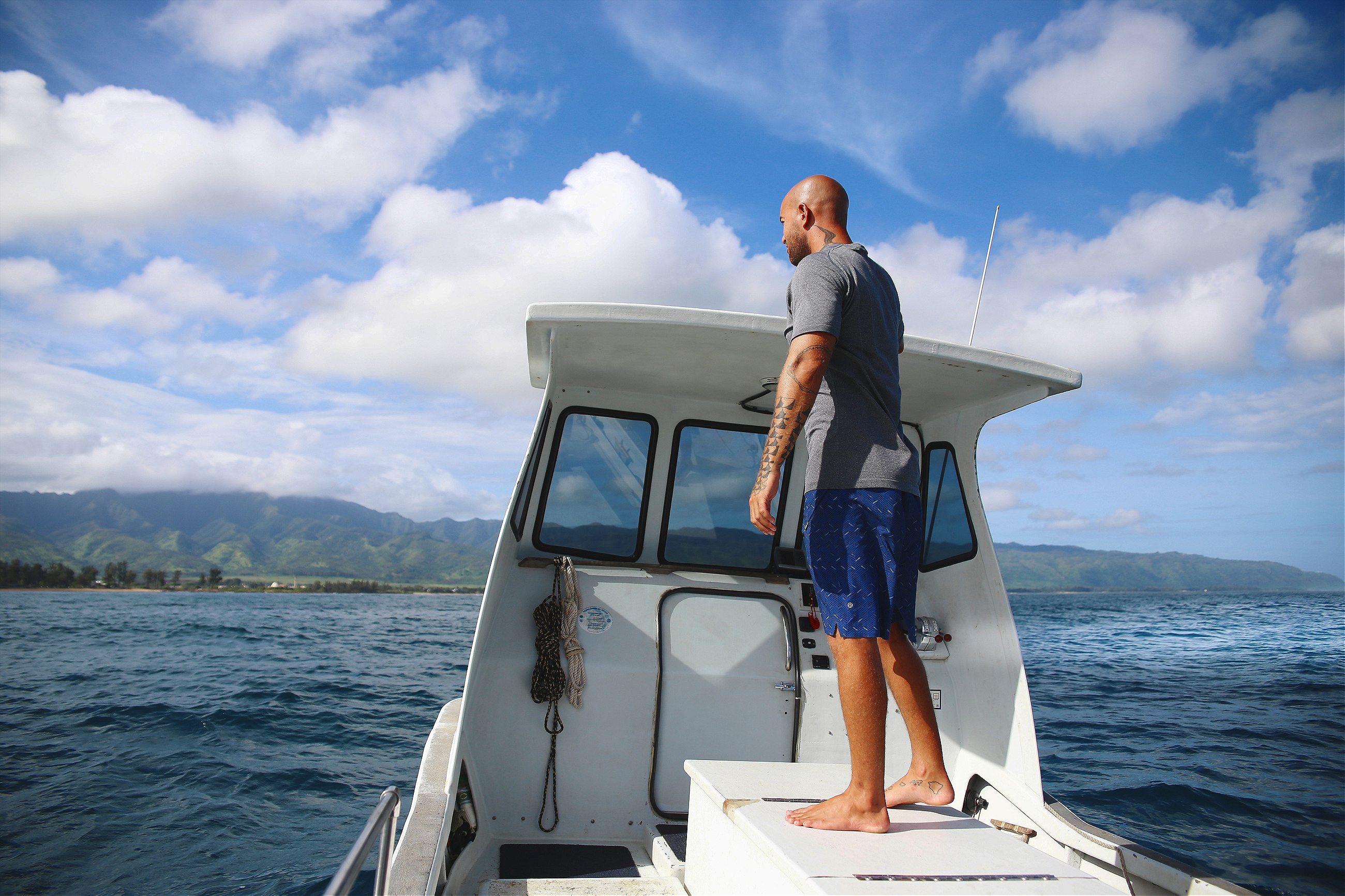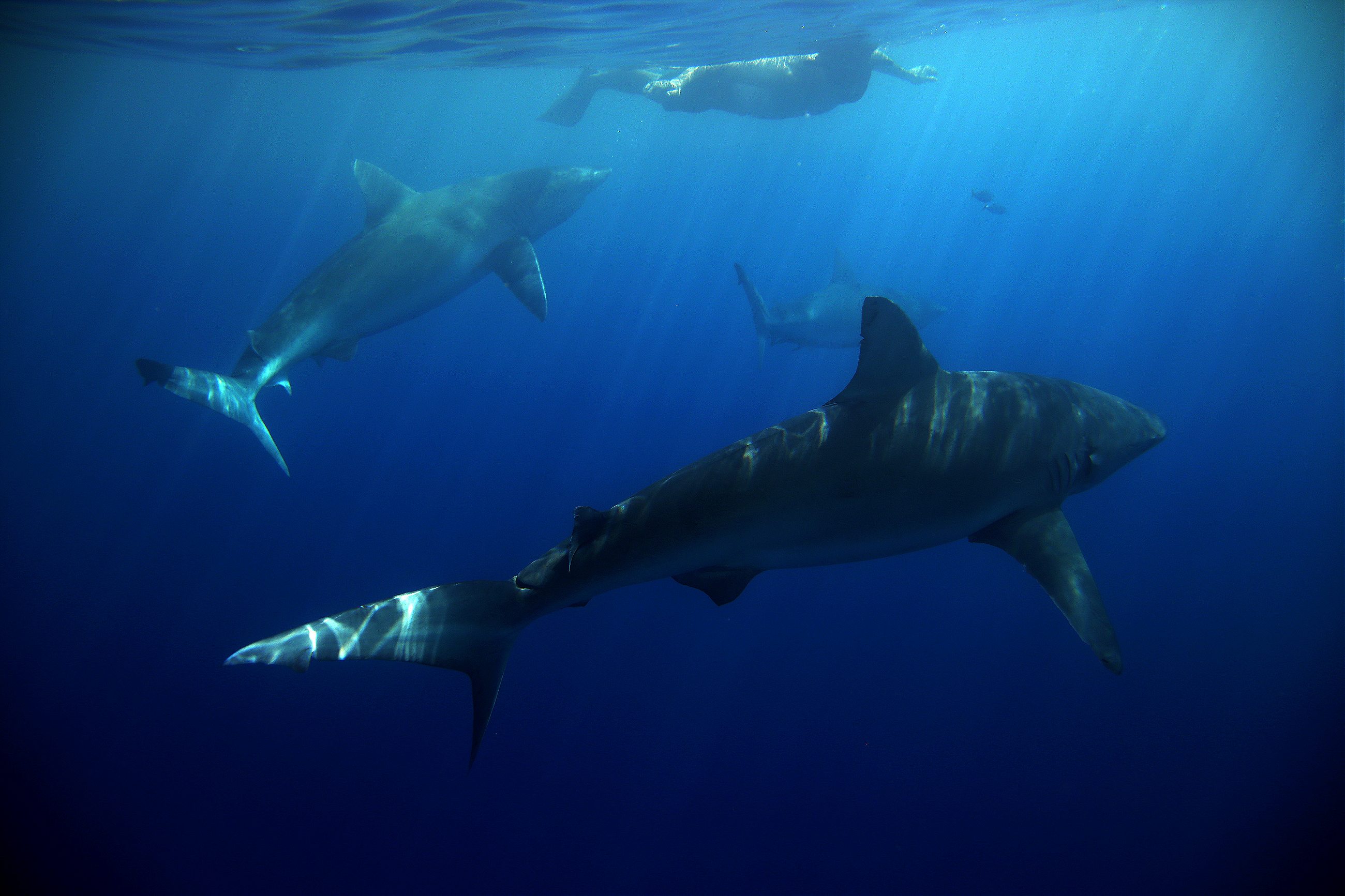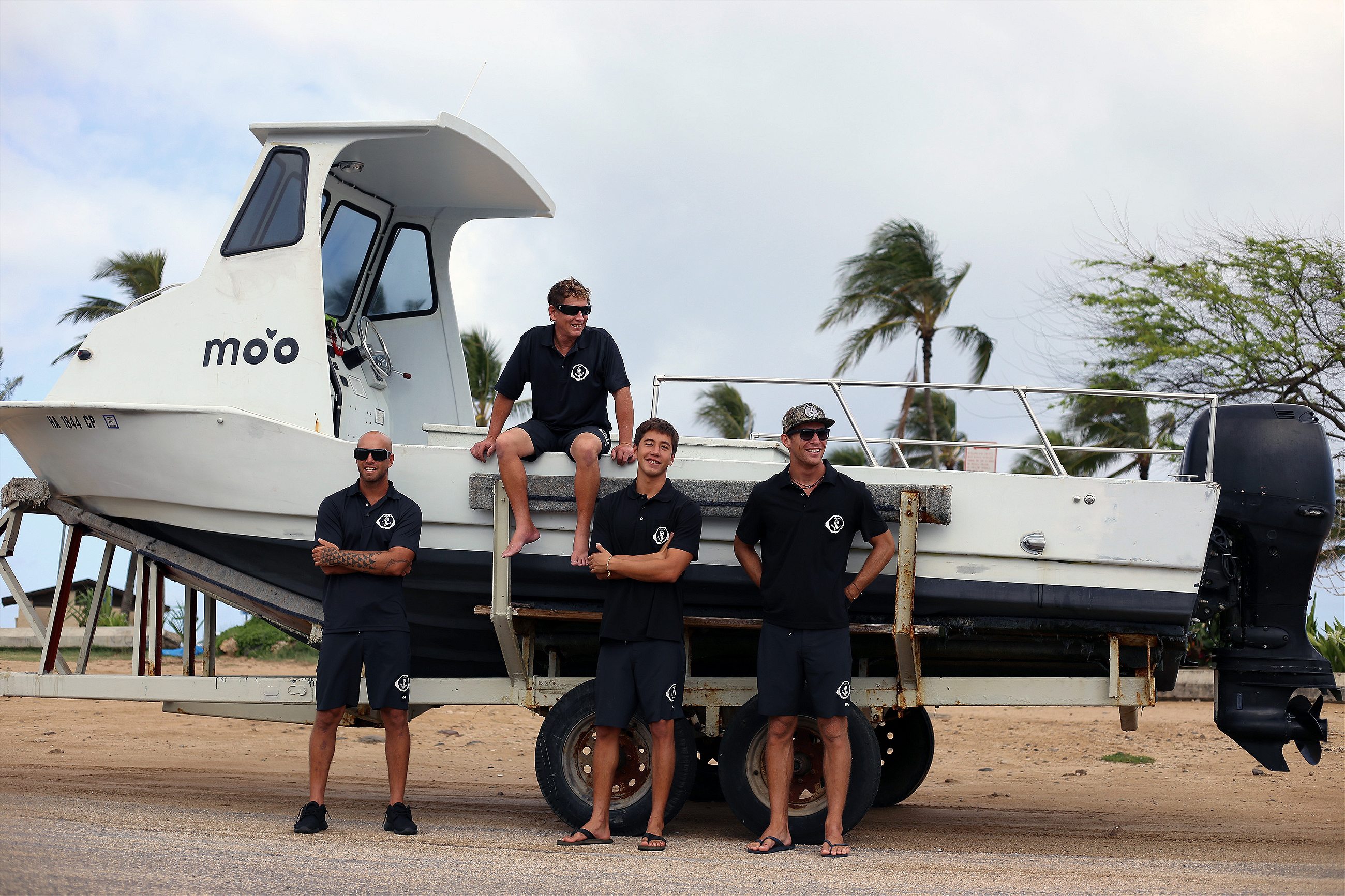Swimming with sharks in a changing Hawaii.
It’s dawn in Haleiwa, a small town on the North Shore of Oahu, and the tradewinds are already blowing, cool but heavy with humidity. It’s quiet, save for a few locals walking their dogs, heading out for a morning surf, or opening up shop for the day. Last night’s rain has left puddles on the road, reflecting a sky dotted with lazy, low-hanging clouds.
At the edge of town, I pull into Haleiwa Boat Harbor and see Kaiwi Berry, broad-shouldered and browned by long days out on the water, leaping barefoot onto the dock from the deck of his boat, the Moʻo. He has a tattoo of fish scales running down the length of one of his forearms. He flashes a smile as I hobble over to him with my dive gear in hand. “Throw your stuff onboard and we’ll get going as soon as my phone charges,” he says. I’m taken aback: Shouldn’t there be a little more fanfare, some kind of basic training involved in swimming with the ocean’s most infamous predators?
In Berry’s opinion, no.
A waterman by heritage and lifeguard by profession, Berry spends most mornings living out your worst fear. Whenever conditions allow, the young kanaka maoli—Native Hawaiian—dives into the Pacific equipped with nothing but a mask and snorkel, to swim among dozens of silver-skinned sharks. From just below the water’s surface, he studies their behavior as they emerge silently from the depths and vie for dominance at the surface, a choreography few people ever have the opportunity to witness firsthand.
Berry has invited me to join him on one of these dives to see firsthand just how much there is to learn from these predators. On any given day, Haleiwa’s population of 4,000 people nearly triples with a flood of tourists seeking pre-packaged paradise and a taste of idyllic Hawaii. As tourism booms across the Islands, development pressures weigh heavily on towns like this one, taking a toll on the environment and the local community. For Berry, this pressure is symptomatic of a growing disregard for the Hawaiian way of life.
“People come here and don’t understand how sacred these islands are,” he says. “As locals, when we see people grabbing turtles or stepping on reefs we want to blow up. But then where do they go to learn about this stuff?” Berry believes that getting people in the water with sharks and challenging their preconceptions about these predators is key to changing their relationship to the land and waters of Hawaii.
I got to know the sharks so well that I would name them
According to Hawaiian tradition, some sharks are ‘aumakua, deified ancestors in animal form. An individual’s relationship with an ʻaumakua begins at birth, and their genealogical connection to that family member can last for generations if properly maintained. If a fisherman traces his ʻaumakua to a particular manō, or shark, he may feed it part of his catch, knowing that it will provide him with guidance and protection in return. The role of sharks as ʻaumakua reflects a vastly different relationship between humans and the natural world, a complex understanding of the role that predators play within delicate ecosystems.
When Captain Cook arrived in the clear waters of Kealakekua Bay in 1778, his crew described in awe the ease with which Hawaiians swam alongside massive sharks, nudging the predators away by their noses when they got too close. But the missionaries that soon followed were not impressed, believing that this closeness to the natural world was primitive, pagan, and sinful. As Hawaiians died of introduced disease by the thousands, the missionaries set about trying to save them by other means, introducing Hawaiians to the Christian god, and condemning traditional practices as sinful.
In the tumult of colonization and catastrophic epidemics, many kanaka maoli families lost their relationship to their ‘aumakua. Though sharks continue to be revered in modern Hawaiian culture, that reverence is tempered by the same Jaws-inspired fear and misinformation that is now common throughout the world. Manō may still be honored, but his power to serve as a direct genealogical link between humans and the natural world has been widely forgotten.
Though his family does not practice the ‘aumakua tradition, Berry’s connection to manō is familial in a different way. Berry traces his lineage back to the island of Maui, but his family has called the North Shore home for four generations. He grew up in the waters just beyond the harbor, going out to sea with his grandfather, legendary black coral diver, Harold Blomfield. By the time Berry was born, Blomfield was working out of Haleiwa as a crab fisherman. “He was my babysitter,” says Berry, “I was on his boat everyday since I was a baby.”
Each day, Blomfield would collect the crab traps he’d laid the night before, and as he threw the old bait overboard, sharks would gather for a free meal. “I got to know them so well that I would name them.” By the time he was ten, Berry was swimming with the sharks, hanging on to their fins as they towed him across the waters’ surface.

Berry and his father, a sun-weathered man with salty, matted hair, ready the Moʻo and we head out to sea. We make our way past Puaena, the easternmost point of the harbor, and hit rougher waters. Over the roar of the wind, Berry says, “This time of year, we see a couple of tiger sharks, which can be pretty overwhelming.” While most of the shark species in the islands are non-aggressive, he tells me, tiger sharks are known as niuhi—maneaters.
There are five divers, and four crewmembers, all friends of Berry’s. While roughly half of the people who board the Moʻo are tourists, today everyone onboard is local, born and raised in Hawaii. They all know the usual adages. Don’t swim at dawn or dusk—feeding time. Don’t swim when it’s murky—feeding time. Don’t swim when the wiliwili tree is in bloom—breeding time. And, finally, don’t surf alone, a rule often ignored.
Shark bites in the waters around Oahu are on the rise, up 56 percent in the last four years. Berry is quick to correct me when I make the mistake of calling them ‘attacks’, a term he says wrongly paints sharks as malicious. In reality, sharks rarely bite humans, and marine biologists almost unanimously agree that the rise in incidents is due to more people swimming in the waters, the result of a massive development boom, a year-round tourism industry, and steady population growth on the island—although that truth is often lost in the sensationalism around the incidents.
In 1991, following a spate of bites, a fearful public led the push for a state sanctioned shark cull, in which Berry’s grandfather took part. “They were killing as many sharks as they could, especially harmless species that are easier to catch, so my grandfather went out and killed a couple of big tiger sharks so that they’d have something to point their anger at, and they’d finally stop.” Shaking his head, he adds, “People just wanted something to place blame on, like, ‘There it is, that monster!’ It’s really just ignorance.”

Three miles out, Berry turns off the engine and points in the direction of two fins cutting through the water. We’ve reached the aggregate zone, an area where sharks congregate naturally in the wild. Chumming the water to attract sharks is illegal in Hawaii, though some cage-tours have been accused of baiting and have come under intense public scrutiny as shark bites have increased over the past few years. Back in 2011, three cage-dive boats were set aflame. Berry shares a kind of disdain for cages. Chum or no chum, to him, cage dives miss the point entirely. “There’s nothing like free-swimming with sharks to make you realize that we’re visitors in their world,” he says.
After he gives a few brief instructions—stay calm, slow your breath and your heartbeat, kick below the surface, don’t splash—Berry dives in. Once his father says it’s safe, we follow one by one. For a few minutes, we wait. Then, Berry raises his head above water and says, “There’s two right there.”
About 30 feet away, the sandbar sharks come into view. Their shape grows clearer as they slip past the boat and make their approach—about seven feet long, with rounded noses and narrow, streamlined bodies. Sandbar sharks are considered harmless to humans, but still, I feel my heart pounding in my chest. They move effortlessly, even elegantly, as they circle us.
From the boat, Berry’s father alerts us to four more sharks. Like images on a Polaroid, they materialize out of a cloud of dark blue. They are Galapagos sharks; silent, prehistoric, and bigger than sandbars we’ve just seen, around nine feet long. One has a gash near its dorsal fin.
While most of Hawaii’s coastal sharks are harmless unless provoked, Galapagos are known to get aggressive and have been responsible for a number of bites. But, as the biggest one slides below us, I feel a strange sense of calm. I see Berry poke his head above water and his face erupts into a wide grin. “That’s a healthy one!” he says to no one in particular.

Back on the Moʻo, I look out across the water to strips of white-sand beach on the island. Somewhere just beyond the beach, is an ancient heiau—temple—dedicated to Kalakiki, the shark god of this stretch of coast. From out here, the coastline looks almost untouched. But up-close, the North Shore is changing rapidly. Behind the wall of coconut trees, the beaches are lined with million dollar vacation rentals, replacing family homes one by one.
Rising land values and costs of living are making it next to impossible for local families to keep afloat—the cost of living in Hawaii is higher than any other state in the country. The community here recently won a fight to stop corporate developers from moving forward on a 20-year plan to build five hotels and 1,000 condo units on the North Shore; but shortly after, dozens of plantation-era buildings were torn down to make room for a large-scale shopping complex. There is always another development project on the horizon. In the face of corporate-led development, the fear of being left behind or pushed out is real. “I built the Moʻo to make sure that my family would have a place here,” Berry says.
Though wresting a living from the sea now requires taking tourists along with him, Berry sees the potential to challenge people’s perspectives one dive at a time. “The idea is that we show them something as simple as the blue of the water, the turtles on the surface, the power of the surf breaks, the sharks that are so big and so natural to this place and our culture. Hopefully that instils a sense of respect.”
As we start back towards shore, I glimpse two dorsal fins disappearing into the deep. “This place is changing. It’s inevitable. But,” Berry adds, “we can steer it in a better direction.”